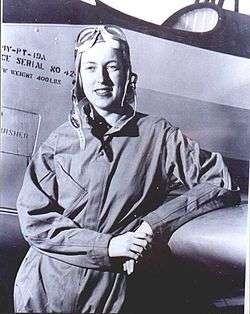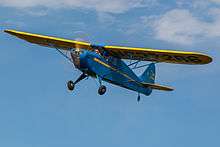Cornelia Fort


Cornelia Clark Fort (February 5, 1919 – March 21, 1943) was a US aviator who became famous for two aviation related events. While conducting a civilian training flight at Pearl Harbor, she was the first US pilot to encounter the Japanese air fleet during the Attack on Pearl Harbor, and narrowly escaped a strafing attack after landing. The next year, Fort became the second member of what became the Women Airforce Service Pilots, and was working as a ferry pilot when she became the first female pilot in American history to die on active duty.
Early life and career
Fort was born to a wealthy and prominent Nashville, Tennessee, family; her father, Rufus Elijah Fort, was a founder of National Life and Accident Insurance Company.[1] She received a high school certificate from the Ward-Belmont School in 1936.[2] She graduated from Sarah Lawrence College in 1939.[3] After college, Fort joined the Junior League of Nashville. She showed an early interest in flying, ultimately training for and earning her pilot's license in Hawaii.
Pearl Harbor attack
While working as a civilian pilot instructor at Pearl Harbor, Cornelia Fort inadvertently became one of the first witnesses to the Japanese Attack on Pearl Harbor that brought the United States into World War II. On December 7, 1941, Fort was in the air near Pearl Harbor teaching takeoffs and landings to a student pilot in an Interstate Cadet monoplane. Hers and a few other civilian aircraft were the only U.S. planes in the air near the harbor at that time. Fort saw a military airplane flying directly toward her and swiftly grabbed the controls from her student to pull up over the oncoming craft. It was then she saw the rising sun insignia on the wings. Within moments, she saw billows of black smoke coming from Pearl Harbor and bombers flying in. She quickly landed the plane at John Rodgers civilian airport near the mouth of Pearl Harbor. The pursuing Zero strafed her plane and the runway as she and her student ran for cover.[4][5] The airport manager was killed and two other civilian planes did not return that morning.[6]
Military service
With all civilian flights grounded in Hawaii, Fort returned to the mainland in early 1942. She made a short movie promoting war bonds that was successful and led to speaking engagements.[7] Later that year, Nancy Love recruited her to serve in the newly established Women's Auxiliary Ferrying Squadron, precursor to the Women Airforce Service Pilots (WASP). She was the second woman accepted into the service.[8] The WAFS ferried military planes to bases within the United States.
Death
Stationed at the 6th Ferrying Group base at Long Beach, California, Cornelia Fort became the first WAFS fatality[9] on March 21, 1943 when another plane being ferried by a male pilot struck the left wing of the BT-13 she was ferrying in a mid-air collision ten miles south of Merkel, Texas.[10][11] At the time of the accident, Cornelia Fort was one of the most accomplished pilots of the WAFS. The footstone of her grave is inscribed, "Killed in the Service of Her Country."[12]
Legacy
Cornelia Fort was portrayed in the film Tora! Tora! Tora! by Jeff Donnell.
The Cornelia Fort Airpark in East Nashville is named after her.
See also
- Women Airforce Service Pilots (WASP)
- Women Airforce Service Pilots Badge
- United States Army Air Forces
- Women's Army Corps (WAC)
- United States Army Air Forces
- United States Air Force
References
- ↑ Rob Simbeck, Daughter of the Air: The Brief Soaring Life of Cornelia Fort, Atlantic, 1999, ISBN 0-87113-688-0, p. 7.
- ↑ 1936 Milestones, p.41
- ↑ Janet R. Daly Bednarek and Michael H. Bednarek, Dreams of Flight: General Aviation in the United States, Texas A & M University Press, 2003, ISBN 1-58544-257-7, p. 81.
- ↑ Sarah Byrn Rickman, Nancy Love and the WASP Ferry Pilots of World War II, University of North Texas Press, 2008, ISBN 978-1-57441-241-3, p. 117.
- ↑ Simbeck, pp. 1-3, 99-100.
- ↑ Simbeck, pp. 4, 109.
- ↑ Marianne Verges, On Silver Wings: The Women Airforce Service Pilots of World War II, 1942-1944, Ballantine, 1991, ISBN 0-345-36534-8, p. 5.
- ↑ Rickman, p. 97.
- ↑ Emily Yellin, Our Mothers' War: American Women at Home and at the Front During World War II, Free Press, 2004, ISBN 0-7432-4514-8 p. 158.
- ↑ Rickman, pp. 116-17.
- ↑ Yellin, p. 157.
- ↑ Rickman, p. 119.
Further reading
- Brinker Tanner, Doris. "Cornelia Fort: A WASP in World War II, Part I," Tennessee Historical Quarterly volume 40 (1981), pp. 381–94; "Cornelia Fort: Pioneer Woman Military Aviator, Part II," Tennessee Historical Quarterly volume 41 (1982), pp. 67–80.
- Fort, Cornelia. "At the Twilight's Last Gleaming: Personal-Experience Narrative of a Member of the WAFS," in The Army Reader, ed. Karl Detzer, Bobbs-Merill, 1943, pp. 313–16. Also in Woman's Home Companion, June 1943.
- Regis, Margaret. When Our Mothers Went to War: An Illustrated History of Women in World War II. NavPublishing, 2008. ISBN 978-1-879932-05-0
External links
- PBS American Experience biography of Cornelia Fort
- Collection of articles on Cornelia Fort
- National Museum of the USAF, fact sheet on Cornelia Fort
- Photos of the crash site